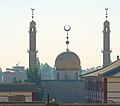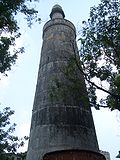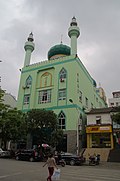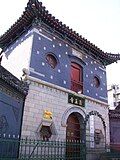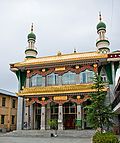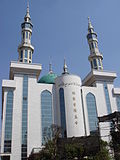
The Hui people are an East Asian ethnoreligious group predominantly composed of Chinese-speaking adherents of Islam. They are distributed throughout China, mainly in the northwestern provinces and in the Zhongyuan region. According to the 2010 census, China is home to approximately 10.5 million Hui people. Outside China, the 170,000 Dungan people of Kazakhstan and Kyrgyzstan, Panthays in Myanmar, Hui Chin Haws in Thailand are also considered part of the Hui ethnicity.

The Id Kah Mosque is a historic mosque and tourist site located in Kashgar, Xinjiang, China.

Puji Temple is a Buddhist temple located on the island of Putuoshan in Zhoushan, Zhejiang, China.
Jews and Judaism in China are predominantly composed of Sephardi Jews and their descendants. Other Jewish ethnic divisions are also represented, including Ashkenazi Jews, Mizrahi Jews and a number of converts.

Islam has been practiced in China since the 7th century CE. Muslims are a minority group in China, representing around 2 percent of the total population. Though Hui Muslims are the most numerous group, the greatest concentration of Muslims are in Xinjiang, which contains a significant Uyghur population. Lesser yet significant populations reside in the regions of Ningxia, Gansu and Qinghai. Of China's 55 officially recognized minority peoples, ten of these groups are predominantly Sunni Muslim.

The Great Mosque of Xi'an is one of the largest premodern mosques in China. Although the mosque was first built in the year 742 AD during the Tang dynasty, its current form was largely constructed in 1384 AD during Emperor Hongwu's reign of the Ming dynasty, as recorded by the Records of Xi'an Municipality (西安府志).

The Huaisheng Mosque is the main mosque of Guangzhou. Rebuilt many times over its history, it is traditionally thought to have been originally built over 1,300 years ago, which would make it one of the oldest mosques in the world.

The Niujie Mosque is the oldest mosque in Beijing, China. It was first built in 996 during the Liao dynasty and was reconstructed as well as enlarged under the Kangxi Emperor of the Qing dynasty.
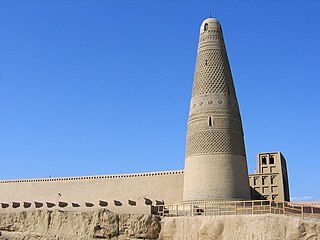
The Emin Minaret or Emin Tower stands by the Uyghur mosque located in Turfan, Xinjiang, China. At 44 meters (144 ft) it is the tallest minaret in China. The Qing Empire conquered this largely Muslim region in the 1750s by defeating the Dzungar Mongols with their superior weaponry in a series of battles. The Uyghurs under Emin Khoja joined the Qing Empire for protection against the Dzungars and the Emin minaret was named after Emin Khoja.

Hedaytul Islam Mosque, near the Chiang Mai Night Bazaar, is one of the biggest mosques in the province, and also one of the seven Chinese mosques in Chiang Mai.

Gedimu or Qadim is the earliest school of Islam in China. It is a Hanafi, non-Sufi school of the Sunni tradition. Its supporters are centered on local mosques, which function as relatively independent units.
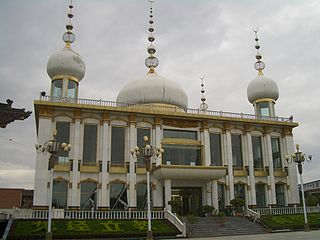
The Huasi Mosque is a mosque in China built during the reign of the Chenghua Emperor in the Ming dynasty. Buddhist temples and imperial palaces were the architecture on which the construction for the mosque was based. It was constructed by Muslims living in West Phoenix Wood Town, now the Bafang areas of Linxia City, Gansu. Ma Zhongying's 1928 revolt in the Muslim conflict in Gansu (1927–30) led to a blaze that destroyed the building. It was capable of holding 2,000 people being 5 mu in area after reconstruction of the Mosque in 1941.

Bukui Mosque is a mosque in Qiqihar, Heilongjiang, China. It is located in Mosque Road off Bukui Street. It was built during the Qing dynasty, and listed in 2006 as a Major Site to Be Protected for Its Historical and Cultural Value at the National Level. It is the largest and oldest mosque in the province.

The Songjiang Mosque, formerly called the Real Religion Mosque, is a mosque in Songjiang District, Shanghai, China. It is the oldest mosque in Shanghai.
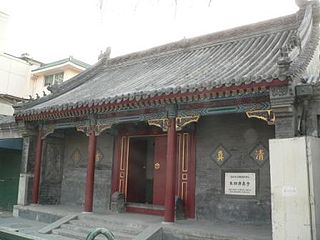
The Dongsi Mosque is a mosque in Dongsi Subdistrict, Dongcheng District, Beijing, China.

Changsha Mosque is a mosque located on Mount Huilong (回龙山) in Tianxin District of Changsha, Hunan, China. Changsha Mosque is the site of Changsha Islamic Association.

Phoenix Mosque is a mosque in Hangzhou, Zhejiang, China. It is known for being one of the four great mosques of China. It is also one of the earliest mosque built in China. The origin of this mosque dates back to the Tang or Song dynasty.

The Weizhou Grand Mosque is a mosque in Tongxin County, Wuzhong City, Ningxia Hui Autonomous Region, China. Plans to demolish the mosque led to widespread protests in 2018 and 2019.

The Beida Mosque is a mosque located in Qinyang, Henan, China. It is the largest architectural complex of mosque in the Central Plains.

Chinese Islamic architecture, Sino-Islamic architecture, or Islamic architecture of China are terms used to indicate the architectural tradition and cultural heritage of the Muslim populations in China, both of mainland and outer China, which has existed since the 8th century CE to the present. With the acculturation of the Islamic religion within the predominant Han-Chinese culture, a unique architectural style emerged among Chinese Muslims. It became standard for them to incorporate traditional Chinese and Islamic architectural elements together for mosques, prayer halls, mausoleums, and other buildings.



